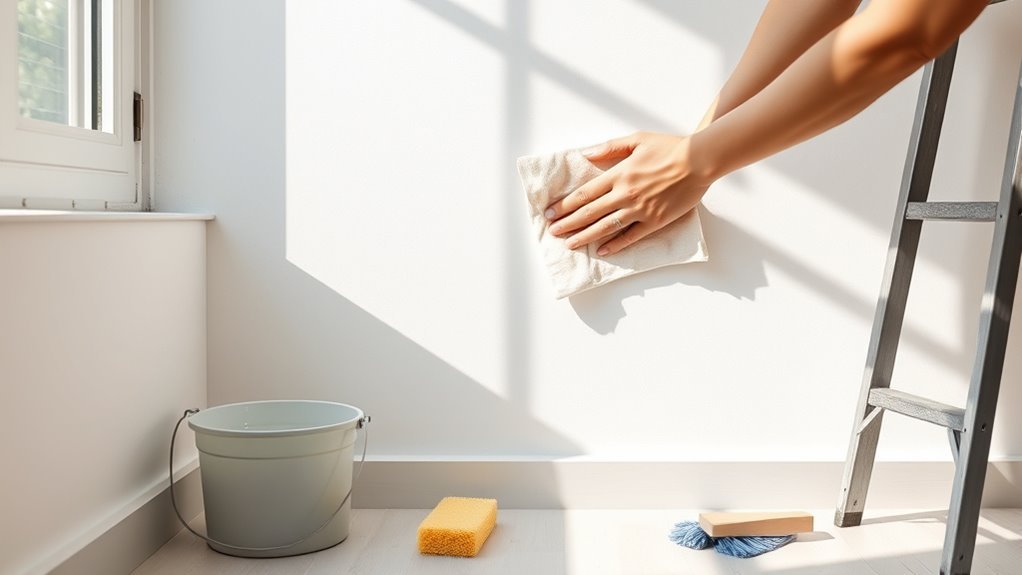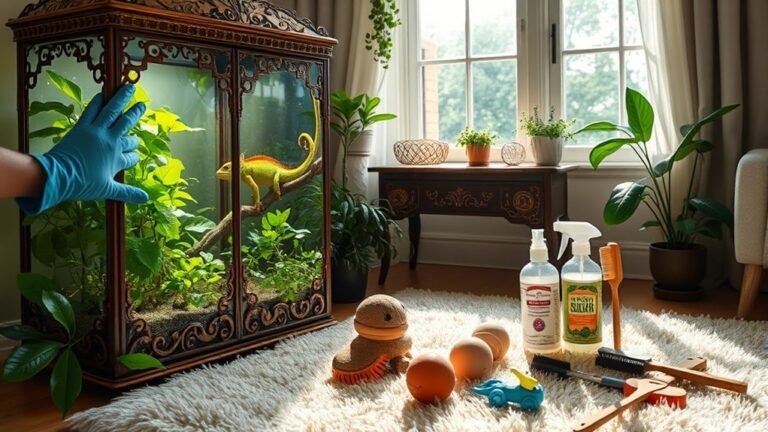How to Clean Your Walls Safely
To clean your walls safely, first identify your paint type—flat finishes need gentle care, while satin or gloss can handle mild scrubbing. Gather soft sponges, microfiber cloths, and mild, eco-friendly cleaners like diluted vinegar or baking soda. Remove dust with a soft brush, protect floors with drop cloths, and always test cleaners on hidden spots. Tackle stains with targeted methods, like baking soda for grease, to avoid damage. With these basics down, you’ll master keeping your walls fresh and spotless.
Assessing Your Wall Surface and Paint Type

Before you start cleaning, it’s essential to identify your wall’s surface and paint type since different materials and finishes react uniquely to cleaning methods. First, examine your wall textures—smooth drywall, textured plaster, or wallpaper—each demands specific care. Next, determine your paint finishes: flat, eggshell, satin, semi-gloss, or gloss. Flat and matte finishes are more delicate and prone to damage from harsh scrubbing, so gentle cleaning is necessary. Satin and semi-gloss finishes are more durable and can handle mild scrubbing with non-abrasive cleaners. Glossy paints offer the most resistance to stains and moisture, allowing a more vigorous cleaning approach. Knowing these details lets you tailor your cleaning strategy, preserving your walls’ integrity while maintaining freedom to refresh your space confidently and effectively.
Gathering the Right Cleaning Supplies
Since the effectiveness of your wall cleaning depends largely on the supplies you choose, gathering the right tools and products is essential. Start with essential tools like a soft sponge, microfiber cloths, a bucket, and a gentle scrub brush to avoid damaging surfaces. Consider eco friendly solutions such as diluted white vinegar, mild castile soap, or baking soda mixtures; these reduce chemical exposure while cleaning effectively. Avoid harsh chemicals that can strip paint or harm indoor air quality. Having a spray bottle handy lets you control application, preventing over-saturation. Don’t forget gloves to protect your skin. By selecting these essentials thoughtfully, you maintain your walls’ integrity and enjoy a cleaning process that aligns with your values for freedom and health.
Preparing Your Walls for Cleaning

Although it might seem straightforward, preparing your walls for cleaning is a critical step that guarantees the process is both effective and safe. Start by removing any dust or cobwebs from the wall surface using a soft brush or vacuum with a brush attachment. This prevents dirt from smearing during cleaning. Next, protect your flooring and furniture with drop cloths or old sheets to maintain freedom of movement. Identify the wall surface type—painted, wallpapered, or textured—as this determines suitable cleaning methods. Test a small, inconspicuous area with your chosen cleaner to avoid damage or discoloration. Ascertain you have adequate lighting and ventilation to work safely and observe results clearly. By thoroughly preparing your walls, you set the stage for efficient and damage-free cleaning.
Techniques for Removing Common Wall Stains
When tackling common wall stains, knowing the right technique for each type can save you time and prevent damage. For grease stains, start by sprinkling baking soda directly on the spot to absorb the oil. Let it sit for 10 minutes, then gently scrub with a damp cloth and mild dish soap. Avoid harsh scrubbing to protect your paint. Crayon marks require a different approach: use a soft cloth dampened with a small amount of toothpaste or baking soda paste. Rub gently in circular motions until the marks fade. Always test your cleaning solution on an inconspicuous area first to verify it doesn’t discolor your wall. These targeted methods help you restore your walls efficiently, keeping your space fresh and free from stubborn stains.
Tips for Maintaining Clean Walls Over Time

Keeping your walls looking fresh goes beyond just tackling stains as they appear. Effective wall maintenance involves establishing a regular cleaning frequency tailored to your home’s needs. You don’t have to clean your walls weekly, but aim for every three to six months to prevent dirt buildup. Use a microfiber cloth or soft sponge with mild detergent, avoiding harsh chemicals that can damage paint. Pay attention to high-traffic areas more frequently. Additionally, control indoor humidity to prevent mold growth and consider using washable paint finishes for easier upkeep. When you spot minor marks, address them promptly to avoid stubborn stains. By setting a consistent routine and using gentle cleaning methods, you’ll keep your walls in pristine condition without feeling restricted by constant upkeep.
Frequently Asked Questions
Can I Use Vinegar to Clean Painted Walls Safely?
Did you know vinegar is used in over 50% of DIY cleaning recipes? You can safely use vinegar solutions on painted surfaces, but you should dilute them—mix one part vinegar with three parts water. Test a small, hidden area first to avoid damage. Use a soft cloth to gently clean, avoiding abrasive scrubbing. This keeps your walls fresh without stripping paint, giving you freedom to maintain your home confidently.
How Often Should I Clean Walls in High-Traffic Areas?
For high traffic zones, frequency guidelines suggest cleaning your walls every 1 to 3 months to keep them looking fresh and prevent grime buildup. You’ll want to adapt based on how quickly dirt accumulates—more frequent cleanings may be needed in especially busy spots. Use gentle cleaners and soft cloths to avoid damage, so your walls stay vibrant without extra wear. Regular upkeep gives you freedom from stubborn stains later on.
Are There Eco-Friendly Wall Cleaning Products Recommended?
Think of your walls as a canvas, deserving gentle care. You can turn to natural cleaners like vinegar, baking soda, and castile soap—famous DIY solutions that respect both your space and the planet. Mix a tablespoon of castile soap with water for a safe spray or paste baking soda on stains. These eco-friendly options let you clean effectively without harsh chemicals, giving you freedom to maintain a fresh, toxin-free home environment.
What Should I Avoid When Cleaning Wallpapered Walls?
When cleaning wallpapered walls, you should avoid harsh chemicals and excessive water, as they can damage the paper and adhesive. Stick to gentle wall cleaning techniques like using a soft sponge or cloth with mild soap and water, wiping carefully. Avoid scrubbing vigorously to protect wallpaper care. Also, don’t use abrasive tools or solvents. Taking these precautions lets you maintain your wallpaper’s look while giving you the freedom to refresh your space safely.
Can Wall Cleaning Damage Electrical Outlets or Switches?
When cleaning near electrical outlets or switches, think of them as delicate flowers in your garden—handle with care. To guarantee outlet protection and switch safety, always turn off the power at the circuit breaker before cleaning. Use a damp (not wet) cloth and avoid spraying cleaners directly onto them. Cover outlets with painter’s tape if needed to prevent moisture intrusion. These steps help you clean freely without risking electrical damage or hazards.






